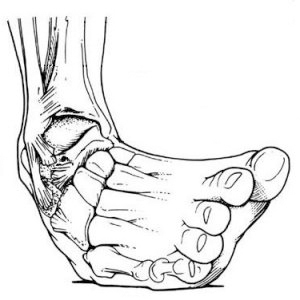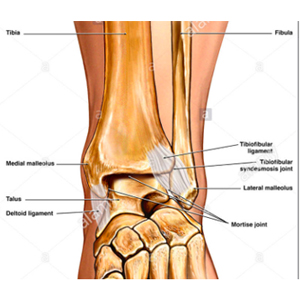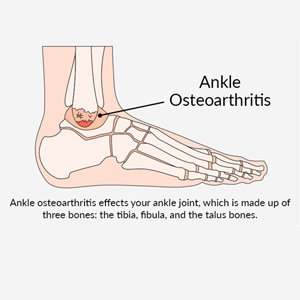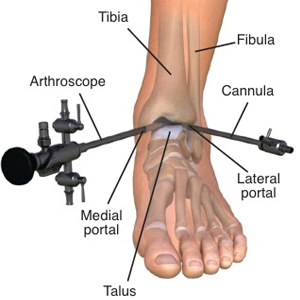Ankle pain, stiffness, swelling, and various deformities warrants primary review of the problem by an orthopaedic surgeon. Acute ankle pain occurs suddenly and include sprains, strains and fractures / trauma whilst chronic ankle injuries develop gradually over time, often through overuse. Early diagnosis and appropriate early treatment can help in managing these ankle pains.
Dr Gautam Tawari is a UK fellowship trained Orthopedic Doctor & Surgeon and the Royal college of surgeons (UK) accredited Sports and ankle arthroscopy surgeon. He uses modern surgical concepts for treatment of all kinds of sports ankle injuries. Ankle instability, ankle ligament tears, Achilles tendon injuries, arthroscopy assisted ankle fusion, management of osteochondral ankle injuries and arthroscopy assisted treatment of ankle fractures / trauma.

Ankle instability presents as repeated “giving way” of the outer (lateral) side of the ankle. It develops after repeated ankle sprains and the “giving way” occurs while activities on uneven grounds or sports.
Presentation
Previous multiple ankle sprains - not adequately healed or was not rehabilitated completely.
Persistent pain and swelling
The ankle feeling unstable
Treatment
The ankle requires, examination, X-rays to access weakening (or stretching) of the ligaments, resulting in instability.
Non-Surgical Treatment
Physiotherapy – This involves various exercises to strengthen the ankle, improve balance and range of motion.
Ankle Support – An ankle brace helps support the ankle and protects it from twisting.
Medications – Nonsteroidal anti-inflammatory drugs (NSAIDs), such as ibuprofen, may be prescribed to reduce pain and inflammation.
Surgical Treatment
Surgery is considered based on the degree of instability or failure of non-surgical treatment. Surgery usually involves repair or reconstruction of the damaged ligament(s). This can be done arthroscopically (key hole) surgery or open surgery.
Rehabilitation is in a brace for 6 weeks followed by full mobilisation, physiotherapy and return to sports.
A fracture is a partial or complete break in a bone. In the ankle, fractures / trauma involve breaking of the bones that form the ankle joint. Ankle fractures can range from less serious type injuries (small pieces of bone that have been pulled off) to severe, shattering-type injuries. Ankle fractures / trauma are commonly caused by the twisting injury to the ankle.
Symptoms
Pain at the site of the fracture, which can extend from the foot to the knee.
Swelling, which occurs along the ankle and foot
Bruising around the ankle
Difficulty in walking and bearing weight on the injured ankle.

Treatment
Most patients with ankle fractures require a splint or half a plaster (resting Backslab). An X-ray of the damaged ankle determines what the fracture looks like, which bones are broken, how separated or displaced the bones are, and it will help determine the proper course of treatment.
Elevation and Ice – Reduction of swelling seen after an ankle fracture can be controlled by elevation of the ankle and regular application of ice.
Splintage – A splint is required to support the broken ankle. This can be converted to a full plaster in mild injuries once the swelling has subsided.
Surgery – Severe fractures of the ankle require surgery. Surgery helps in restoring alignment of the broken bone is essential to full recovery. This is the best way to minimise the risk of arthritis and restore the ankle to as close to normal as possible. The surgical treatment is known as an open reduction and internal fixation or ORIF of the ankle.
As the ankle heals after surgery, the joint is protected and activity is restricted in a plaster. The plaster is removed around 6 weeks and mobilisation and physiotherapy begins to encourage put weight on the ankle joint. Total recovery time is approximately 2- 3 months.

Arthritis occurs when the cartilage (gliding surface) of a joint breaks down, this loss of cartilage in a joint leads to painful motion and swelling. In the ankle, arthritis is most commonly after injury or trauma or multiple severe ankle sprains. This is called post-traumatic arthritis. Other types of arthritis include osteoarthritis of the ankle.
Symptoms
Patients with ankle arthritis typically present with swelling, stiffness, and pain. Symptoms appear gradually, but can occur suddenly as well. Patients complain of difficulty in walking, especially on uneven surfaces.
Treatment
Confirmation of arthritis can be done with clinical examination and Xrays. Treatment of foot and ankle arthritis addresses both pain and joint deformity.
Non-surgical Treatment
The initial treatment for ankle arthritis is generally non-surgical. Treatments may includes:
Medication - Medications such as non-steroidal medication (nsaids), which calm down inflammation in the ankle. They can be taken by mouth or applied as a gel directly to the ankle.
Ankle Support/Brace - Braces limit motion in the ankle, which can help prevent further damage in the joint and decrease pain.
Activity modification – Reducing high-impact activities (such as running and sports like tennis or basketball) and switching to exercises like cycling and swimming can help relieve the pain.
Physiotherapy – This helps to strengthen the muscles that stabilize the ankle. This is particularly helpful in early arthritis when combined with activity modification.
Injection - A steroid injection can help reduce pain and improve function for the patients. Other types of injections, such as hyaluronic acid or gel injections and platelet-rich plasma (PRP) injections can be considered in selective conditions.
Surgical Treatment
Surgical treatments vary depending on the severity of the arthritis. Ankle Arthroscopy can help to remove bone spurs or loose pieces of bone in the ankle or repair cartilage if the cartilage loss is small.
In cases of advanced cartilage loss, an ankle replacement or ankle fusion is advocated.
In an ankle replacement, the worn areas are removed and replaced with metal and plastic.
In an ankle fusion, the bones are knitted together using plates and/or screws. This can be done using ankle arthroscopy as a modern method of doing this surgery.
Ankle arthroscopy is a minimally invasive surgical procedure and a modern technique in treating problems of the ankle joint.
Ankle arthroscopy uses a thin fibre-optic camera (arthroscope) that can magnify and transmit images to a video screen. Small keyholes are made to pass instruments and address the problem causing ankle pain.
Ankle arthroscopies reduce ankle pain and help improve overall function.
Arthroscopy can also be used to diagnose and treat different disorders of the ankle joint. Procedures that can be done with the help of arthroscopy include -

Arthroscopic Ankle fusion - Treatment option for patients with ankle arthritis. Ankle arthroscopy offers a minimally invasive way to perform ankle fusion. Results can be equal to or better than open techniques.
Ankle Fracture fixation - Ankle arthroscopy may be used along with open techniques to fix an ankle fracture. This help to ensure good fracture reduction, also information can be obtained regarding the normalcy of ankle cartilage.
Ankle Instability - Ligaments of the ankle can become stretched out, which can lead to a feeling that the ankle gives way. These ligaments can be tightened with surgery. Arthroscopic techniques may be an option for treating moderate instability.